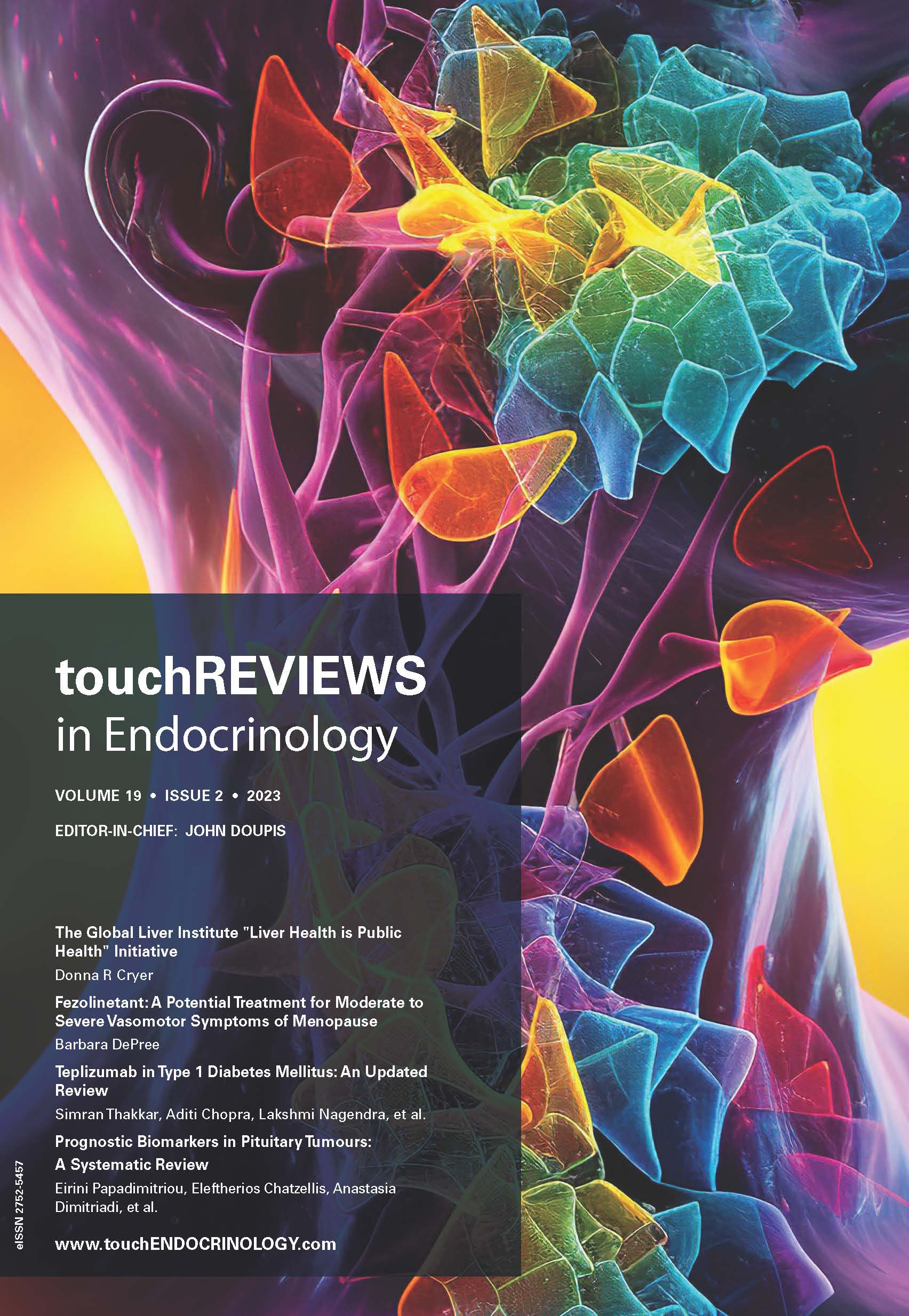European Endocrinology 16.1 – Spring 2020
Welcome to the spring edition of European Endocrinology! This issue covers a wide range of topics including diabetes, obesity, thyroid, endocrine oncology, hypothyroidism and paediatric endocrinology.
Obesity continues to be one of the greatest challenges to the healthcare practitioner, and is discussed in an editorial and study. Diabetes is the focus of many of our articles, reflecting its global impact, and we cover topics such as the challenges of diagnosing and managing diabetic polyneuropathy; discrepancies between insulin administration guidelines and current practice, and the interplay between pituitary health and type 2 diabetes. This issue features two original research articles on the subject of growth hormone and the three case reports provide an opportunity to learn about rare presentations of common diseases.
European Endocrinology would like to thank all our expert authors for their time, our Editorial Board for their
constant guidance and all organisations and society partners for their ongoing support.
Enjoy and happy reading!
Foreword
Welcome to the latest edition of European Endocrinology. The recent outbreak of COVID-19 has impacted on all aspects of our profession, from the cancellation of medical conferences to the risk that COVID-19 imposes on patients with diabetes. Educating our patients on the importance of optimal glycaemic control has never been more important. This issue features […]
Editorial
Obesity, defined as the presence of excess body fat, is a major public health problem which appears to have become endemic to the human race.1 Owing to its multifactorial etiopathogenesis, clinical manifestations and comorbidities, the management of obesity can be more challenging than that of other chronic medical conditions. Although there has been much debate […]
Reviews
Diabetic polyneuropathy (DPN) is the most common microvascular complication of diabetes, affecting approximately 50% of all people with diabetes (type 1 diabetes [T1D] and type 2 diabetes [T2D]).1 DPN is a major cause of disability due to sensory loss, gait instability and fall‐related injuries,1–5 and is the strongest risk factor for diabetic foot ulceration and amputation.1–4 Up to […]
The prevalence of diabetes in the worldwide adult population has increased from 4.7% to 8.5% since 1980.1 Peripheral neuropathy is found in 30–90% patients with diabetes mellitus, and 16–34% of people with diabetes suffer from painful diabetic neuropathy (PDN).2,3 South Asians are particularly prone to this complication which leads to decreased quality of life and […]
The pituitary gland, or hypophysis, is the ‘master gland’ that secretes multiple hormones which regulate the functioning of other endocrine organs, such as the thyroid, adrenal cortex and gonads. Though none of the major pituitary hormones directly control the endocrine glandular components of the pancreas, there are multiple indirect interactions that alter glucose homeostasis. Bromocriptine […]
The armamentarium of anticancer drugs available to an oncologist has grown rapidly over the past few decades. The use of cancer immunotherapy and targeted therapy has become more popular in the last few years. It has also become increasingly clear that various anticancer agents, both conventional and newer ones, may be associated with certain off-target […]
Original Research
Diabetes mellitus (DM) is a major global health problem. The national prevalence of diabetes in Bangladesh is 6.9% which is increasing at an alarming rate.1 Though the prevalence of type 1 diabetes mellitus (T1DM) is low in this area, the prevalence of gestational diabetes and young-onset T2DM is very high.1 Insulin is an indispensable component […]
Obesity is now a major public health issue with an increasing prevalence worldwide.1 Obesity is also closely linked to increased morbidity and mortality caused by the complications related to obesity, such as type II diabetes, atherosclerosis, hypertension, infertility, neurodegenerative diseases, and even cancers.2,3 Obesity is the deposition of excess fat in the body caused by […]
Growth hormone (GH) is approved in children to treat growth failure in several indications including GH deficiency, Turner syndrome and short children born small for gestational age,1 and is approved in the USA but not in Europe for the treatment of idiopathic short stature (ISS).2 ISS describes short children with normal GH secretion, with height >2 standard […]
Growth hormone deficiency (GHD) is an endocrine cause of short stature. GHD may be idiopathic, due to brain tumours affecting the pituitary gland, morphologic pituitary abnormalities, or genetic defects.1,2 The diagnosis of GHD is based on auxologic criteria and laboratory studies including tests of growth hormone (GH) secretion by stimulating GH release.3 The identification of […]
Case Reports
Hyperinsulinaemic Hypoglycaemia (HH) is a very rare disease with an estimated incidence of 1/50,000,1 and includes a clinical, histological and genetic heterogeneous group of disorders characterised by hypoglycaemia, hyperinsulinism or, more specifically, increased C-peptide level and inappropriate low blood levels of ketone bodies during a hypoglycaemic event. HH is a variable condition: it can be […]
Hyperthyroidism is a disease characterised by excess thyroid hormone synthesis and secretion from the thyroid gland. It is most frequently caused by Graves’ disease and toxic nodular goiter. Systemic complications involving the respiratory, cardiac and gastrointestinal systems, as well as ocular manifestations, such as exophthalmos, can be caused by hyperthyroidism. Common cardiologic complications are atrial […]
Catecholamine-secreting tumours that arise from chromaffin cells of the adrenal medulla and the sympathetic ganglia are respectively referred to as pheochromocytomas and paragangliomas. The term paraganglioma is also used for tumours derived from parasympathetic tissue in the head and neck, most of which do not produce catecholamines.1 The classic triad of symptoms in patients with […]

Trending Topic
Thyroid nodules are common worldwide, and their prevalence is increasing. Most nodules are asymptomatic and detected incidentally on cross-sectional imaging or physical examination. In rare cases (10–15%), nodules are malignant and require diagnostic evaluation. Even malignant nodules frequently show non-aggressive behaviour.1 The increase in the incidence of thyroid cancer is unfairly distributed globally, and the […]
Journal Archive
touchREVIEWS in Endocrinology (previously European Endocrinology) is a peer-reviewed, free-to-access, bi-annual journal comprising review articles, case reports, editorials, special reports and original research. It features balanced and comprehensive articles written by leading authorities, addressing the most important and salient developments in the field of endocrinology.
Latest articles videos and clinical updates - straight to your inbox
Log into your Touch Account
Earn and track your CME credits on the go, save articles for later, and follow the latest congress coverage.
Register now for FREE Access
Register for free to hear about the latest expert-led education, peer-reviewed articles, conference highlights, and innovative CME activities.
Sign up with an Email
Or use a Social Account.
This Functionality is for
Members Only
Explore the latest in medical education and stay current in your field. Create a free account to track your learning.



















